
The Holy Grail is a treasure that serves as an important motif in Arthurian literature. Various traditions describe the Holy Grail as a cup, dish, or stone with miraculous healing powers, sometimes providing eternal youth or sustenance in infinite abundance, often guarded in the custody of the Fisher King and located in the hidden Grail castle. By analogy, any elusive object or goal of great significance may be perceived as a "holy grail" by those seeking such.

Monty Python's Life of Brian is a 1979 British comedy film starring and written by the comedy group Monty Python. It was directed by Jones. The film tells the story of Brian Cohen, a young Jewish-Roman man who is born on the same day as—and next door to—Jesus, and is subsequently mistaken for the Messiah.
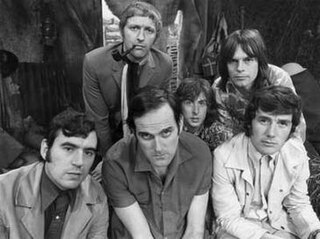
Monty Python were a British comedy troupe formed in 1969 consisting of Graham Chapman, John Cleese, Terry Gilliam, Eric Idle, Terry Jones, and Michael Palin. The group came to prominence for the sketch comedy series Monty Python's Flying Circus, which aired on the BBC from 1969 to 1974. Their work then developed into a larger collection that included live shows, films, albums, books, and musicals; their influence on comedy has been compared to the Beatles' influence on music. Their sketch show has been called "an important moment in the evolution of television comedy".

Monty Python and the Holy Grail is a 1975 British comedy film satirizing the Arthurian legend, written and performed by the Monty Python comedy group and directed by Gilliam and Jones in their feature directorial debuts. It was conceived during the hiatus between the third and fourth series of their BBC Television series Monty Python's Flying Circus.
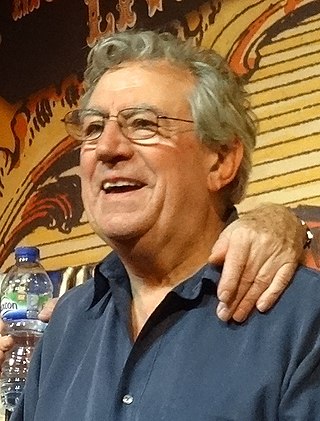
Terence Graham Parry Jones was a Welsh actor, comedian, director, historian, writer and member of the Monty Python comedy troupe.

Eric Idle is an English actor, comedian, songwriter, musician, screenwriter and playwright. He was a member of the British comedy group Monty Python and the parody rock band the Rutles. Idle studied at Pembroke College, Cambridge, and joined Cambridge University Footlights. He reached stardom when he co-created and acted in the sketch series Monty Python's Flying Circus (1969–1974) and the films Monty Python and the Holy Grail (1975), Life of Brian (1979) and The Meaning of Life (1983) with John Cleese, Michael Palin, Terry Gilliam, Terry Jones, and Graham Chapman.

"The Lumberjack Song" is a comedy song by the comedy troupe Monty Python. The song was written and composed by Terry Jones, Michael Palin, and Fred Tomlinson.

The Black Knight is a fictional character who first appeared as a minor antagonist in the 1975 comedy film Monty Python and the Holy Grail by the Monty Python comedy troupe. A knight dressed in black who wears a helmet completely concealing his face, he is based on the black knight of the Arthurian legend. Like most of the characters in Holy Grail, he is played by a member of Monty Python, namely John Cleese, who primarily portrays Lancelot in the film.

Monty Python's The Meaning of Life, also known simply as The Meaning of Life, is a 1983 British musical sketch comedy film written and performed by the Monty Python troupe, directed by Terry Jones. The Meaning of Life was the last feature film to star all six Python members before the death of Graham Chapman in 1989.

A shrubbery, shrub border or shrub garden is a part of a garden where shrubs, mostly flowering species, are thickly planted. The original shrubberies were mostly sections of large gardens, with one or more paths winding through it, a less-remembered aspect of the English landscape garden with very few original 18th-century examples surviving. As the fashion spread to smaller gardens, linear shrub borders covered up walls and fences, and were typically underplanted with smaller herbaceous flowering plants. By the late 20th century, shrubs, trees and smaller plants tend to be mixed together in the most visible parts of the garden, hopefully blending successfully. At the same time, shrubs, especially very large ones, have become part of the woodland garden, mixed in with trees, both native species and imported ornamental varieties.

Bedivere is one of the earliest characters to be featured in the legend of King Arthur, originally described in several Welsh texts as the one-handed great warrior named Bedwyr Bedrydant. Arthurian chivalric romances, inspired by his portrayal in the chronicle Historia Regum Britanniae, portray Bedivere as a Knight of the Round Table of King Arthur who serves as Arthur's marshal and is frequently associated with his brother Lucan and his cousin Griflet as well as with Kay. In the English versions, Bedivere notably assumes Griflet's hitherto traditional role from French romances as the one who eventually returns Excalibur to the Lady of the Lake after Arthur's last battle.
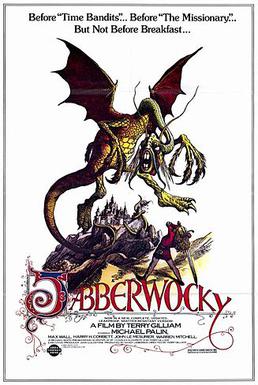
Jabberwocky is a 1977 British fantasy comedy film co-written and directed by Terry Gilliam. Jabberwocky stars Michael Palin as Dennis, a cooper's apprentice, who is forced through clumsy, often slapstick misfortunes to hunt a terrible dragon after the death of his father. The film's title is taken from the nonsense poem "Jabberwocky" from Lewis Carroll's Through the Looking-Glass (1871).
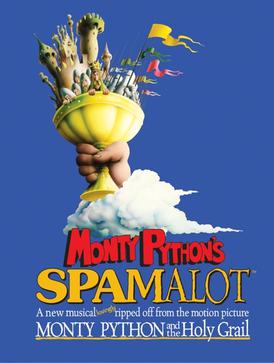
Spamalot is a stage musical with score by John Du Prez and Eric Idle, with lyrics and book by Idle. Based on the 1975 film Monty Python and the Holy Grail, the musical offers a highly irreverent parody of Arthurian legend.
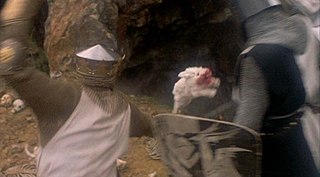
The Killer Rabbit of Caerbannog is a fictional character in the Monty Python film Monty Python and the Holy Grail. The scene in Holy Grail was written by Graham Chapman and John Cleese. The rabbit is the antagonist in a major set piece battle, and makes a similar appearance in Spamalot, a musical inspired by the movie. The iconic status of this scene was important in establishing the viability of the musical.

The Album of the Soundtrack of the Trailer of the Film of Monty Python and the Holy Grail is the first film soundtrack album by Monty Python, released in 1975. It features selected scenes from Monty Python and the Holy Grail interspersed with a large volume of new studio material, much of which centers on a spoof screening of the film at the Classic Silbury Hill Theatre. Also among the new items is the "Marilyn Monroe" sketch, which Graham Chapman co-wrote with Douglas Adams - the pair having recently collaborated on the fourth series of Monty Python.
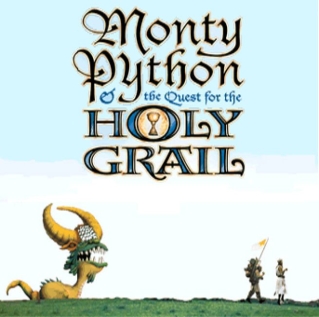
Monty Python & the Quest for the Holy Grail is an adventure game created by 7th Level in 1996 for Windows. The game is based on the 1975 film Monty Python and the Holy Grail and was the second of three Monty Python games created by 7th Level.

Monty Python Live at Aspen was a reunion show featuring the surviving members of the Monty Python team: John Cleese, Terry Gilliam, Eric Idle, Terry Jones and Michael Palin, appearing on stage together for the first time since their Hollywood Bowl shows in 1980. Filmed on 7 March 1998 at the Wheeler Opera House in Colorado as part of The US Comedy Arts Festival, it featured the five Pythons in an interview with host Robert Klein. The late Graham Chapman was also allegedly in attendance as his "ashes" were brought out in an urn with his portrait attached to the front, only to be knocked over by Terry Gilliam.
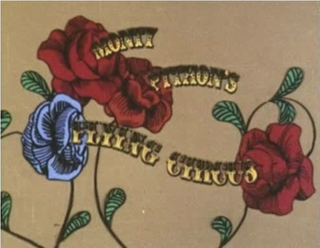
Monty Python's Flying Circus is a British surreal sketch comedy series created by and starring Graham Chapman, John Cleese, Eric Idle, Terry Jones, Michael Palin, and Terry Gilliam, who became known collectively as "Monty Python", or the "Pythons". The first episode was recorded at the BBC on 7 September 1969 and premiered on 5 October on BBC1, with 45 episodes airing over four series from 1969 to 1974, plus two episodes for German TV. A feature film adaptation of several sketches, And Now for Something Completely Different, was released in 1971.
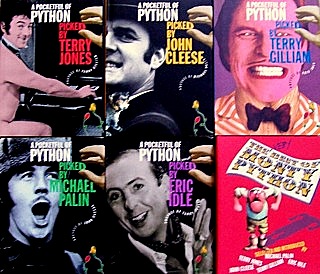
A Pocketful of Python is a series of five books by the Monty Python team, in which each of the surviving members selects their favourite material from the group’s TV series, films, records and books. The first two volumes, by Terry Jones and John Cleese, were released in 1999 as part of the team’s 30th anniversary celebrations. Two further volumes, by Terry Gilliam and Michael Palin, followed in 2000 while the final volume, by Eric Idle, was eventually released in 2002. Each team member’s volume includes a preface written by one of the other Pythons. In 2006 all five volumes were released as a single paperback edition, entitled The Very Best of Monty Python.



















